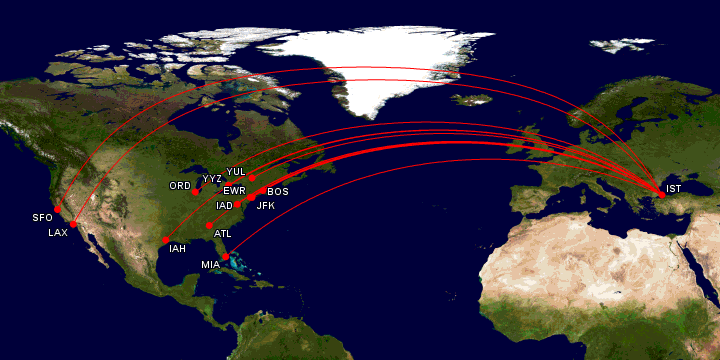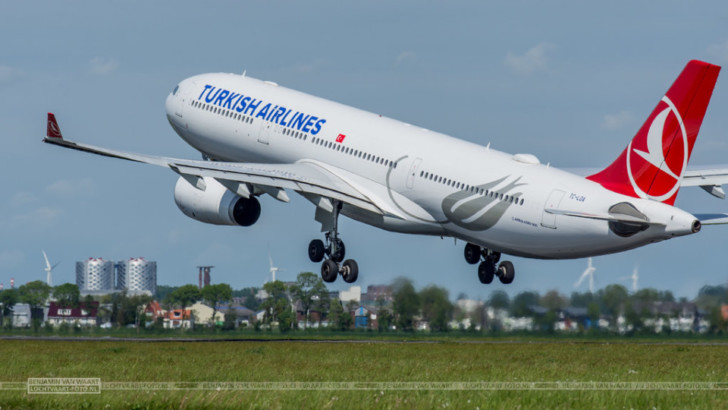Turkish Airlines CEO Bilal Eksi announced on Twitter that the carrier will launch service between Istanbul and Newark on May 25, 2020. The route will be operated daily using Airbus A330-300 equipment. Turkish Airlines had announced its intention to serve Newark last year, but could not find slots that fit its intended timings. Newark will become Turkish Airlines’ 10th US destination and 17th in the Americas.
The flight schedules for the new route will be as follow.
| Flight # | Routing | Dep | Arr |
| TK29 | EWR-IST | 0:25 | 17:10 |
| TK30 | IST-EWR | 18:35 | 22:30 |
Turkish Airlines already serves New York JFK with three daily flights, but Newark was actually its primary New York gateway in the early 1990s. Newark-Istanbul was also briefly operated by United Airlines in 2012 and 2013.
Newark service is focused on O&D travel to MENA and Asia
The timings for the new flights to Newark are primarily optimized for connectivity in Istanbul. Turkish Airlines has strong connectivity to Eastern Europe, the Middle East, North Africa, and all of Asia in that period. In particular, the unique strength of Turkish Airlines’ hub in Istanbul is secondary and tertiary airports in those regions (like Erbil, Kigali, Ishfahan, and Dushanbe), so the carrier should be able to find a niche alongside Emirates, Qatar Airways, and Etihad at Newark and in the broader New York market.
Newark serves both New York City itself, and the broader metro area including New Jersey and parts of New York State and Connecticut. As a result, there are ethnic enclaves from nearly every part of the world that should help Turkish fill these planes with visiting family and relatives. The one relative hole in Turkish’s network relative to the Newark route is its service to India, which is limited to a single daily flight to each of Mumbai and Delhi. Still, the route is likely to enjoy strong load factors, though there isn’t enough origin and destination (O&D) traffic to Istanbul for all four daily flights.
Meanwhile, the route offers next to no connectivity at Newark with Star Alliance partner United Airlines. The 10:30 pm arrival is too late for the vast majority of domestic departures from Newark. There are roughly 25 United flights that arrive between 9:00 pm and 11:00 pm (connecting time between 1.5 and 3.5 hours), so that will provide a little bit of feed for the Newark-Istanbul routing. But this route will ultimately sink or swim on the back of O&D traffic at Newark.
What’s Next For Turkish Airlines in the US
While there are still plenty of opportunities for Turkish in the Americas as a whole (Lima, Santiago, Rio de Janeiro, and Vancouver come to mind), things are less clear in the US. In addition to three daily flights at JFK, Turkish also flies twice daily to Washington Dulles, daily to San Francisco, Los Angeles, Houston, Chicago, Miami, and Boston, and five times per week to Atlanta.

Beyond those destinations, Denver, Charlotte, Phoenix, Orlando, Las Vegas, Salt Lake City, and Minneapolis don’t have enough O&D demand to the regions where Turkish Airlines offers strong connectivity, and Philadelphia already has service from Qatar Airways. After that you get into markets like Austin and Portland, which are likely to small to justify a longer distance flight to Istanbul. Seattle, Detroit, and Dallas Fort Worth are the other three markets that stand out.
Detroit makes a lot of sense, as it has strong demand for travel to and from the Middle East (East Asia also has strong demand but is well served). Seattle is tough because long haul demand is centered on East Asia, a region that is already well served (and arguably over-served from the airport). Dallas Fort Worth, meanwhile, has been tough sledding for the existing Middle Eastern carriers. Moreover, the demand for the regions where Istanbul makes for strong connectivity is heavily focused on South Asia. Turkish’s lack of a strong Indian network really holds them back in this regard. So it’s not clear that there are a ton of open opportunities for Turkish in the US outside of Detroit.






